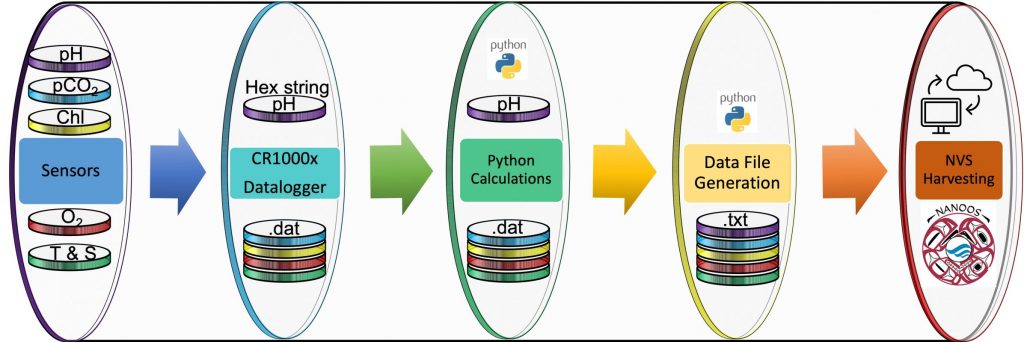The Friday Harbor Laboratories Ocean Observatory (FHLOO)
Data are streaming live to the Northwest Association of Networked Ocean Observing Systems’ (NANOOS) Visualization System (NVS) website.
Data are permanently archived and publicly available at the Biological and Chemical Oceanography Data Management Office (BCO-DMO) website.
Access previous FHLOO data HERE
The FHLOO is stationed off of FHL’s floating dock, ~1-2 meters beneath the surface. It consists of a suite of sensors working in concert to produce live data visualizations of current conditions in the Salish Sea. Read more about the launch of this project and the hopes for its impact in the November 2020 edition of Friday Harbor Labs Tide Bites.
The observatory is equipped with the following instruments:
| PARAMETER | UNIT | INSTRUMENT |
| Temperature | °C / °F | Sea-Bird Electronics 37-SM/SMP |
| Carbon Dioxide (partial pressure) | µatm | Sunburst Sensors SAMI-CO2 |
| Chlorophyll | µg/L | WET Labs ECO FLNTUS |
| Conductivity | S/m | Sea-Bird Electronics 37-SM/SMP |
| Dissolved Oxygen Concentration | mg/L | Aanderaa Optode 4351 |
| Dissolved Oxygen Percent Saturation | % | Aanderaa Optode 4351 |
| pH (total scale) | Sunburst Sensors SAMI-pH | |
| Salinity | PSU | Sea-Bird Electronics 37-SM/SMP |
| Turbidity | NTU | WETLabs ECO FLNTUS |
| Current Velocity | Sontek ADP 250 kHz |

Acknowledgements:
Funding from the National Science Foundation, Award # 1418875 (PIs Ken Sebens, Emily Carrington, Alex Gagnon, Danny Grunbaum, Jan Newton, and Billie Swalla: Instrumentation at UW Friday Harbor Laboratories for Studies of the Biological Impacts of Ocean Acidification and Ocean Change).
Additional funding support from the UW College of the Environment’s Office of the Dean, FHL, UW Student Technology Fund, NANOOS, the WA Ocean Acidification Center, and the Ocean Nexus Center.
Dr. Emilio Mayorga helped integrate the SAMI-pH and the rest of the sensors with NVS.
Austin McHugh programmed and installed the Campbell Scientific CR1000x Datalogger that controls and polls each sensor.
Dylan Crosby and Kristy Kull provided technical support.